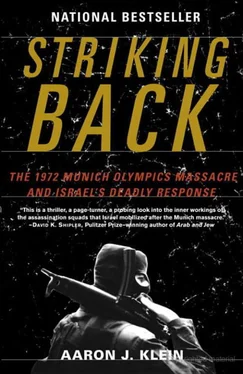Bseiso did go out to dinner. The Caesarea surveillance team shadowed him, undetected, the whole time. They checked that he wasn’t being guarded by his DST hosts. Bseiso, his bodyguard, and an unidentified Lebanese woman spent a pleasant night at a Hippopotamus Grill chain restaurant. It was after midnight when Bseiso picked up the tab and went back to the Jeep. He sat in the back, his bodyguard drove, and his friend sat in the front seat. They had a very loud, animated conversation in Arabic. A short drive brought them to the entrance of the Méridien Montparnasse. The Rue du Commandant Mouchotte was quiet; few cars passed by.
Bseiso got out and said goodbye to his friends. He took one step back, preparing to move in the direction of the hotel. A few seconds later, two young men approached him. Their walk was loose, casual. Tom, the point man, raised his hand and pulled the trigger. The Beretta 0.22 issued its shots in silence, the retorts muzzled by a silencer. The three bullets hit Bseiso in the head. He fell on the spot, next to his friend’s car, his final inhalation a gurgle. The hot cartridges were caught, along with the clues they held, in a sturdy cloth bag attached to the pistol. Within seconds, the assassin and his backup were rapidly retreating down the street.
“Abie,” the commander of the squad, waited for them near the corner, 150 yards away. He watched them cross to the other side of Avenue du Maine and, from the other side of the street, at a more casual pace, watched their backs. This standard procedure was meant to thwart a mishap during the escape phase of a mission—a highly unlikely scenario, since it takes bystanders many long seconds, if not minutes, to realize that an assassination has just taken place. Nonetheless, the possibility couldn’t be ignored. Within twenty seconds the point man and his number two were at the corner of a one-way street. According to Mossad procedure, the getaway car always waits two 90-degree turns from the scene of an operation. The pair made a left onto Rue Vandamme, where the waiting car had kept its motor running.
Abie suddenly noticed two figures coming after his men. They were breathing heavily and speaking animatedly. This was a fast-approaching threat; they needed to be stopped. They could not be allowed to turn the corner and see the escape vehicle, or, even worse, commit the license plate to memory. Abie started toward them, his quick pace authoritative and threatening. When he was within fifteen feet of the pair he pulled out his Beretta. Holding it in front of their faces, he shouted: “Stop!” The weapon froze them in their tracks. They put their hands in the air, stumbled backward, turned around, and broke into a run in the direction of the hotel. Abie pocketed his gun and walked down Avenue du Maine. He watched his men turn left onto the narrow street and got into a second car waiting for him on his side of the avenue. He checked his watch: fifty-five seconds had elapsed since the first shot was fired. He smiled to himself. The account was squared; the mission, a success. He pushed a button, sending confirmation to the commander of Caesarea. In less than two hours, the point man, his number two, the squad leader, the commander of Caesarea, his staff officers, and Shabtai Shavit, had all left French soil.
• • •
Brigadier General Azriel Nevo, Prime Minister Yitzhak Shamir’s military aide, lay awake in bed waiting for the red, top secret telephone to ring. He picked it up quickly and heard a familiar voice say, “Azriel, it went according to plan.” He recognized “Amir,” Shabtai Shavit’s chief of staff, on the other end of the line.
“Thanks, I’ll pass it on.”
Nevo sat up in bed and dialed Shamir’s number. The prime minister picked up on the first ring. “Mr. Prime Minister, I just got word from Shavit’s office, the Paris affair went smoothly.”
“Thank you,” Shamir said, and hung up.
Nevo put down the phone. Shamir, he thought, had nerves of steel. He and Shavit were two of a kind. Nevo went back to sleep thinking about how Le Figaro ’s headline might read the next morning.
News of the assassination traveled fast. Some Western media outlets automatically attributed the hit to the Mossad, even pointing to the possibility of revenge for the Munich murders of 1972. The Bseiso family, one of the largest and most respected clans in Gaza City, set up a traditional mourning tent, where they received hundreds of visitors. Bseiso was hailed as a “victim of the Intifada.” Yasser Arafat, the founder of Fatah, was in Amman, Jordan, recovering from head injuries sustained when his plane was forced to crash-land in the Libyan desert during a sandstorm earlier that year.
Arafat told dozens of reporters that the Israeli Mossad was responsible for the assassination. “I warned them,” he said, “ dir balkum, be careful, the Mossad will hunt us down one by one, officer by officer…. Unfortunately, we have lost a national hero.”
Israeli authorities never issued an official response. One of Prime Minister Shamir’s spokespersons told The New York Times that the accusation was “totally and completely ridiculous.” The head of Military Intelligence, Major General Uri Saguy, responded to Arafat’s claims with an unperturbed: “ Nu, so Arafat says we did it, hat ehr gezukt ” (Yiddish for: He says so, so what?).
Officers at the Mossad’s Brussels station were shocked. “Eyal,” a high-ranking officer in Caesarea, hurried up the stairs to see “Haggai,” his superior.
“Didn’t we take this guy off the list?” Eyal asked.
“We took him off. I don’t know what’s going on.” Haggai shrugged.
Both of them knew the deceased. Back in 1988, the two of them, in previous posts as officers at Mossad headquarters in Tel Aviv, had erased his name from the Mossad hit list. The removal had gone through all the proper channels. Nahum Admoni, the head of the Mossad at the time, had approved the move. Yet someone had put Bseiso back on the list and then led a covert operation to kill him on French soil. That someone was none other than Shabtai Shavit—a brilliant tactician and professional, who had excelled at every post he held along the chain of command, and who had the ear and the confidence of every prime minister he worked under.
Early in 1992, Shavit called a former protégé, the current head of Caesarea, to a short meeting. He asked him to check which of the terrorists involved in the Munich attack were still alive. Shavit was old-school, one of those who refused to close the book on Munich. As far as he was concerned, the state of Israel had painted a well-deserved target on the faces of everyone involved in the planning or the execution of the massacre. They would all pay with their lives; when and where was of no consequence. Mossad combatants were charged with carrying out the assassination orders, which had been passed down from Golda Meir to each successive prime minister.
Shavit believed in Israel’s responsibility to its citizens, at home and abroad—he believed in the necessity of fulfilling this executive order not just because he saw it as moral and just, but because he knew that no one else would carry it out in his place. He would do all in his power to see the mission through.
A few months after the assassination, Shavit was officially invited to meet the newly appointed head of the DST. Forgoing pleasantries, the French intelligence officer fired his opening volley: “We know you killed Bseiso. We’re still working on the proof. When it comes through, you’ll get what’s coming to you. In no way am I willing to allow you to turn Paris into your stage for acts of war and assassinations. We’re not going back to the early seventies, when you did whatever the hell you wanted here. I will not allow it to happen,” he said, pounding his fist on the table.
Читать дальше












